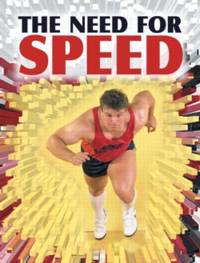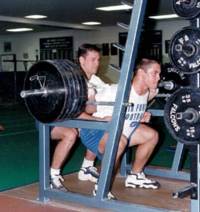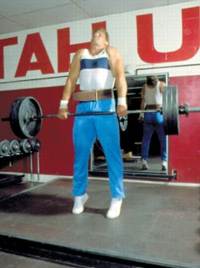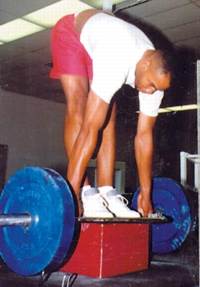THE NEED FOR SPEEDA compelation from BFS speed articles, manuals and booklets.By Bigger Faster Stronger Published: Summer 2000 Speed is one of the highest valued skills for athletes in every field. Speed often makes the difference between winning and losing. In order to increase your speed, BFS recommends the following proven methods: Strength 1. You Must Squat Parallel Every muscle in the body needs to be trained for running especially the hamstring and the glute muscles. This is true because they provide the greatest amount of power and explosiveness needed for a quick take-off. Many people squat several inches above parallel instead of completely parallel. This isolates the quadriceps resulting in a muscle imbalance which can cause tension, strains, and other related muscle injuries. 2. You Must Power Clean Cleaning also prepares muscles for take-off. The explosive movement occurring off the blocks is very similar to the explosive movement of the Power clean. When Cleaning, start with a jump stance, which is a narrow stance similar to sprinting. When the bar crosses the knees explode up with full energy. The Power Clean trains the body for that sprint explosion needed for a quick powerful start. 3. You Must Do Straight Leg Deadlifts The Straight Leg Deadlift (SLDL) is the key to quick speed. As flexibility and strength increase, so does speed. The SLDL strengthens and stretches the glutes and hamstrings at the same time, increasing overall speed. The SLDL can cut as much as two tenths off your forty time. The important thing to remember with the SLDL is to not load up the bar and go for maxes. In fact, this lift isn’t even recorded. Do not use any more than 40% of your squat max (most athletes only need 80 to 100 pounds). Do two sets of ten repetitions. Squat down and lift the bar as in the Deadlift. Once standing, you’re ready to begin. Keeping the knees locked and in a controlled manner, lower the bar as far as possible, even as far as to touch the bar on the toes. It is very important to consider this a stretching exercise rather than one for strength. This will keep athletes from trying to load up the bar which can be unsafe. Flexibility 4. You Must Stretch Correctly and Hard Everyday The further the muscle can stretch, the further the leg or any muscle can travel. When muscles are free and loose it makes the motion of that muscle more fluid and functional. This smooth motion takes the power from the muscle and transfers it smoothly and quickly to the ground; greatly increasing the speed. Plyometrics 5. Do Jumping and Bounding Plyometrics Twice per Week Plyometrics bridge the gap between the work in the weightroom and any arena of competition. This makes the power developed in the weightroom functional. Often, at our clinics, we will have an athlete do three consecutive standing long jumps for a couple of sets and measure the distance. We will then have the athlete spend ten minutes going through a BFS Box Jumping routine immediately followed by another triple jump test. It is common for the athlete to jump 3 to 10 inches farther after the routine. Sprint Technique Guidelines Now that the basic off-field exercise techniques have been covered, the BFS 8-point Sprint Technique System will effectively assist athletes in increasing on-field speed. The following is a list of guidelines for the 8-Point Sprint System: 1. The Sprint System should be done directly after the warm-up and flexibility period. 2. Do no more than nine sprints per workout. Do three sprints with focus on the head, do three focusing on the torso and three with focus on the legs. If the athlete tends to have more difficulty in one area, increase the number of sprints for that area while decreasing the number of sprints for the other areas. 3. The distance for each sprint should be 10-50 yards with recovery time being 15-20 seconds (usually the time it takes to walk back). 4. The speed for each sprint should be ½ to 3/4 speed . . . never full speed for learning purposes. 5. The Sprint System should never be considered a part of the athletic conditioning, only a part of the learning process. 6. The Sprint System should be done 2-4 times weekly in-season and off-season, in groups or individually. Feedback from a coach, parent or teammate is important. Concentrate on one area of the body for each sprint (head, torso, legs). On the last sprint of each set, combine the eight points to achieve a full speed sprint. Time and record the last sprint of each set in your logbook. Try to break the record each week. Practice this system two or three times a week when the body is FRESH. Following these guidelines and EVERY athlete can improve speed dramatically! __________ THE BFS 8 POINT SPRINT SYSTEM The BFS 8-Point Sprint Technique System singles out 8 specific points that must be looked at when assessing an athletes technique. These points are as follows: HEAD 1. Head - The head should be level and unwavering 2. Eyes - The eyes should be on a target straight ahead. TORSO 3. Back - The back should be upright and slightly arched. 4. Arms - The shoulders should rotate vigorously with elbows fixed in a 90 degree angle. Emphasize thrusting the elbows back. 5. Wrists - The wrists should simulate a whip action as the shoulder rotates back. LEGS 6. Legs - Initial leg action is to lift forward then up. 7. Feet - The feet should make the initial plant directly under the hips–not out in front of the body. The toes should be kept up–don’t let the foot drop. 8. Knees - On the follow-through or end of the leg drive, the knee should fully extend. |
 |
|
|
 |
|
The Parallel Squat. Athletes must go completely parallel. |
 |
|
The Power Clean. Cleans develop explosive power. |
 |
|
The Straight Leg Deadlift can cut forty times by 2 tenths. |